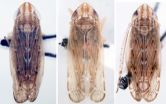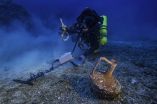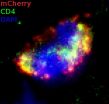(Press-News.org) An international research team comprised of German, Israeli and American ecologists, including Dr. Claus Holzapfel, Dept. of Biological Sciences, Rutgers University-Newark, has conducted unique long-term experiments in Israel to test predictions of climate change, and has concluded that plant communities in the Holy Land can cope with climate change of "biblical" dimensions. Their findings appear in the current issue of Nature Communications at http://www.nature.com/ncomms/2014/141006/ncomms6102/pdf/ncomms6102.pdf.
When taking global climate change into account, many scientists predict dire ecological consequences around the world. The Middle East in particular has been thought to be vulnerable, since east Mediterranean ecosystems not only are hotspots of biodiversity, but also contain many of the wild ancestors of important crop plants and therefore harbor a rich genetic reservoir for them.
In a region with the lowest per-capita water availability, rainfall is predicted to decrease further in the near future, and could spell extreme hardship for the function of these unique ecosystems and possibly endanger the survival of important genetic resources.
For nine years the research team of German, Israeli and American ecologists subjected extremely species-rich plant communities to experimental drought designed to correspond to predicted future climate scenarios. For this, the study used four different ecosystems aligned along a steep, natural aridity gradient that ranges from extreme desert (3-4"annual rainfall) to moist Mediterranean woodland (32").
The recently published study demonstrates that in contrast to predicted changes, no measurable changes were seen in the vegetation even after nine years of rainfall manipulations. None of the crucial vegetation characteristics, neither species richness and composition, nor density or biomass - a particularly important trait for these ecosystems traditionally used as rangelands - changed appreciably in the rainfall manipulations.
These conclusions were reached regardless of whether the sites were subjected to more or less rain.
"Based on our study, the going hypothesis that all arid regions will react strongly to climate change needs to be amended," stated Dr. Katja Tielbörger (University of Tübingen in Germany), the lead author of the study.
One of the reasons for the high resilience of the ecosystems studied is likely the high natural variability in rainfall for which the region has been known throughout history. The climate scenarios tested included a decrease of rainfall to about 30% of the current values. That amount of rainfall seems to fall within the natural "comfort zone" of wild-growing plants. Archeological sources (and similar descriptions in the Bible) speak of such dramatic variation in climate over the course of centuries.
The team of scientists implemented a novel experimental approach in which irrigation and rain-out shelters were used not only to compare plots with changed climate within a site with un-manipulated controls, but the placing of sites along the steep aridity gradient also allowed testing the long-standing assumption that with climate change, species will track their climate zone and their ranges will simply shift.
Such shifts, commonly assumed by numerous climate-envelope models, have now for the first time been scientifically tested and have not been confirmed.
"Our experiment is likely the most extensive climate change study ever done, because of the number of sites involved, the long duration of experimental manipulations, and the immense species richness", stated Dr. Claus Holzapfel of Rutgers University-Newark, adding: "These facts add to the robustness of our results."
The study serves to decrease the "doomsday" scenario of climate change for the arid Middle East, despite the fact that the conclusions reached by the research team are only applicable to the specific regions studied. The authors of the study caution that these results should not be used to address global issues of climate change. However, the researchers maintain that their results are important for understanding and countering specific consequences of climate change in the Middle East.
INFORMATION:
Dr. Holzapfel can be reached at holzapfe@andromeda.rutgers.edu or 973-353-5385.
Original publication
Katja Tielbörger, Mark. C. Bilton, Johannes Metz, Jaime Kigel, Claus Holzapfel, Edwin Lebrija-Trejos, Irit Konsens, Hadas A. Parag, Marcelo Sternberg: Middle-Eastern plant communities tolerate nine years of drought in a large-scale climate change experiment. Nature Communications Oct. 2014 http://www.nature.com/ncomms/2014/141006/ncomms6102/pdf/ncomms6102.pdf.
Plant communities in Holy Land can cope with climate change of 'biblical' dimensions
Middle Eastern vegetation demonstrates high resilience to climate change
2014-10-09
ELSE PRESS RELEASES FROM THIS DATE:
NASA's Hubble maps the temperature and water vapor on an extreme exoplanet
2014-10-09
A team of scientists using NASA's Hubble Space Telescope has made the most detailed global map yet of the glow from a turbulent planet outside our solar system, revealing its secrets of air temperatures and water vapor.
Hubble observations show the exoplanet, called WASP-43b, is no place to call home. It is a world of extremes, where seething winds howl at the speed of sound from a 3,000-degree-Fahrenheit "day" side, hot enough to melt steel, to a pitch-black "night" side with plunging temperatures below 1,000 degrees Fahrenheit.
Astronomers have mapped the temperatures ...
DNA nano-foundries cast custom-shaped metal nanoparticles
2014-10-09
Researchers at the Wyss Institute for Biologically Inspired Engineering at Harvard University have unveiled a new method to form tiny 3D metal nanoparticles in prescribed shapes and dimensions using DNA, Nature's building block, as a construction mold.
The ability to mold inorganic nanoparticles out of materials such as gold and silver in precisely designed 3D shapes is a significant breakthrough that has the potential to advance laser technology, microscopy, solar cells, electronics, environmental testing, disease detection and more.
"We built tiny foundries made ...
Balancing birds and biofuels: Grasslands support more species than cornfields
2014-10-09
MADISON, Wis. – In Wisconsin, bioenergy is for the birds. Really.
In a study published today in the journal PLOS ONE, University of Wisconsin-Madison and Wisconsin Department of Natural Resources (DNR) scientists examined whether corn and perennial grassland fields in southern Wisconsin could provide both biomass for bioenergy production and bountiful bird habitat.
The research team found that where there are grasslands, there are birds. Grass-and-wildflower-dominated fields supported more than three times as many bird species as cornfields, including 10 imperiled ...
New leafhopper species named after University of Illinois entomologist
2014-10-09
Three new species of leafhoppers from China in the genus Futasujinus were recently identified during a review of leafhoppers in museum collections in China, the UK, and Illinois. One of them, Futasujinus dietrichi, was "named after Dr. Chris Dietrich, University of Illinois, USA, in recognition of his good work on leafhoppers." The new species are described in an article in Annals of the Entomological Society of America.
The other two species are Futasujinus truncatus and Futasujinus hastatus. Both species epithets allude to processes on their aedeagal shafts.
All three ...
Ebola research shows rapid control interventions key factor in preventing spread
2014-10-09
Tempe, Ariz. (Oct. 9, 2014) - New Ebola research demonstrates that quick and forceful implementation of control interventions are necessary to control outbreaks and avoid far worse scenarios.
Researchers analyzed up-to-date epidemiological data of Ebola cases in Nigeria as of Oct. 1, 2014, in order to estimate the case fatality rate, proportion of health care workers infected, transmission progression and impact of control interventions on the size of the epidemic.
"Rapid and forceful control measures are necessary as is demonstrated by the Nigerian success story. This ...
Stunning finds from ancient Greek shipwreck
2014-10-09
A Greek and international team of divers and archaeologists has retrieved stunning new finds from an ancient Greek ship that sank more than 2,000 years ago off the remote island of Antikythera. The rescued antiquities include tableware, ship components, and a giant bronze spear that would have belonged to a life-sized warrior statue.
The Antikythera wreck was first discovered in 1900 by sponge divers who were blown off course by a storm. They subsequently recovered a spectacular haul of ancient treasure including bronze and marble statues, jewellery, furniture, luxury ...
New technique yields fast results in drug, biomedical testing
2014-10-09
WEST LAFAYETTE, Ind. – A new technique makes it possible to quickly detect the presence of drugs or to monitor certain medical conditions using only a single drop of blood or urine, representing a potential tool for clinicians and law enforcement.
The technique works by extracting minute quantities of target molecules contained in specimens of blood, urine or other biological fluids, and then testing the sample with a mass spectrometer.
Testing carried out with the technology takes minutes, whereas conventional laboratory methods take hours or days to yield results ...
Embryos receive parent-specific layers of information, study shows
2014-10-09
SAN FRANCISCO -- The information that interprets the genetic code in a new embryo differs depending on whether it comes from the father or mother, researchers at San Francisco State University have found.
The research, detailed in an article published today in the journal PLOS Genetics, sheds light on the multilayered process of how a sperm and egg pass along information needed for successful reproduction. Though one layer is the DNA code that is transferred, the new study identifies information not encoded by DNA, a so-called "epigenetic" layer of information that helps ...
Entire female reproductive tract susceptible to HIV infection in macaque model
2014-10-09
Most women are infected with HIV through vaginal intercourse, and without effective vaccines or microbicides, women who cannot negotiate condom use by their partners remain vulnerable. How exactly the virus establishes infection in the female reproductive tract (FRT) remains poorly understood. A study published on October 9th in PLOS Pathogens reports surprising results from a study of HIV transmission in the FRT of rhesus macaques.
Most studies of HIV transmission after vaginal exposure to date have been done in rhesus macaques and focused on the cervix, the lower part ...
Snakes and snake-like robots show how sidewinders conquer sandy slopes
2014-10-09
VIDEO:
This video explains research done to understand the motion used by sidewinder snakes to climb sandy slopes and to apply that motion to a snake-like robot. Researchers from Georgia Tech,...
Click here for more information.
The amazing ability of sidewinder snakes to quickly climb sandy slopes was once something biologists only vaguely understood and roboticists only dreamed of replicating. By studying the snakes in a unique bed of inclined sand and using a snake-like robot ...
LAST 30 PRESS RELEASES:
Normalizing blood sugar can halve heart attack risk
Lowering blood sugar cuts heart attack risk in people with prediabetes
Study links genetic variants to risk of blinding eye disease in premature infants
Non-opioid ‘pain sponge’ therapy halts cartilage degeneration and relieves chronic pain
AI can pick up cultural values by mimicking how kids learn
China’s ecological redlines offer fast track to 30 x 30 global conservation goal
Invisible indoor threats: emerging household contaminants and their growing risks to human health
Adding antibody treatment to chemo boosts outcomes for children with rare cancer
Germline pathogenic variants among women without a history of breast cancer
Tanning beds triple melanoma risk, potentially causing broad DNA damage
Unique bond identified as key to viral infection speed
Indoor tanning makes youthful skin much older on a genetic level
Mouse model sheds new light on the causes and potential solutions to human GI problems linked to muscular dystrophy
The Journal of Nuclear Medicine ahead-of-print tip sheet: December 12, 2025
Smarter tools for peering into the microscopic world
Applications open for funding to conduct research in the Kinsey Institute archives
Global measure underestimates the severity of food insecurity
Child survivors of critical illness are missing out on timely follow up care
Risk-based vs annual breast cancer screening / the WISDOM randomized clinical trial
University of Toronto launches Electric Vehicle Innovation Ontario to accelerate advanced EV technologies and build Canada’s innovation advantage
Early relapse predicts poor outcomes in aggressive blood cancer
American College of Lifestyle Medicine applauds two CMS models aligned with lifestyle medicine practice and reimbursement
Clinical trial finds cannabis use not a barrier to quitting nicotine vaping
Supplemental nutrition assistance program policies and food insecurity
Switching immune cells to “night mode” could limit damage after a heart attack, study suggests
URI-based Global RIghts Project report spotlights continued troubling trends in worldwide inhumane treatment
Neutrophils are less aggressive at night, explaining why nighttime heart attacks cause less damage than daytime events
Menopausal hormone therapy may not pose breast cancer risk for women with BRCA mutations
Mobile health tool may improve quality of life for adolescent and young adult breast cancer survivors
Acupuncture may help improve perceived breast cancer-related cognitive difficulties over usual care
[Press-News.org] Plant communities in Holy Land can cope with climate change of 'biblical' dimensionsMiddle Eastern vegetation demonstrates high resilience to climate change





